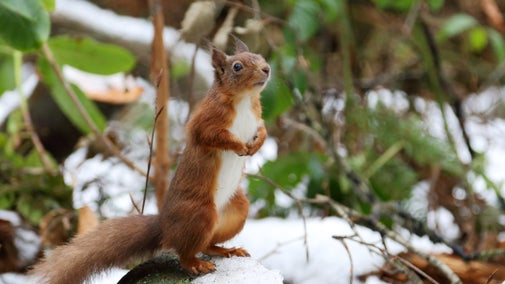
Donate
Everyone needs nature, now more than ever. Donate today and you could help people and nature to thrive at the places we care for.

Find out more about our work on the estate from revealing an 800-year-old Norman motte to caring for red squirrels and a new breeding pair of endangered barn owls. Discover how our conservation work helps to create space for nature and wildlife to thrive.
We’ve worked with volunteers to uncover a Norman motte dating back 800 years that’s now been revealed from undergrowth. Overgrown shrubbery and invasive trees were beginning to threaten the condition of the hidden monument. We embarked on a project to uncover the true scale of the motte not seen for centuries.
To get a clearer picture of the motte we commissioned a survey to create high resolution digital three-dimensional maps. The images revealed an imposing structure that stands nearly 8m tall with a surrounding ditch nearly 5m wide.
Before the work started, the motte was barely visible due to the dense thickness of the vegetation. It has taken a team of volunteer rangers and local corporate volunteers over 850 hours to clear the area of shrub and invasive trees.
Work has also involved opening up space to provide trails to reach the motte and the surrounding area. This work enables light to reach the surrounding hedgerows so that new wild plants and flowers can grow.
- Toby Edwards, National Trust area ranger
Much of the work involved the removal of non-native invasive plant species like laurel and sycamore. The motte will now be managed as a woodland glade with new micro habitat opportunities created for solitary and mining bee species. We also hope that the glade will benefit different moths and butterflies, from larvae to adult flight stage insects.

Work on the landscape has resulted in a richly diverse and vibrant eco system at Mount Stewart. We’re delighted to say that this habitat now provides a home to a pair of breeding barn owls.
It is estimated that there are less than 30 pairs of barn owls in Northern Ireland, with the species having been in decline here for some time. To begin to address this on a local level, Mount Stewart has been working in partnership with Ulster Wildlife. Together we’ve been able to bring back barn owls to Mount Stewart.
There are a number of challenges facing the barn owl population in Northern Ireland including habitat loss, reduced food sources, lack of nesting sites and use of rodenticides. In Northern Ireland wood mice, young rats and pygmy shrews make up the majority of their diet.
Since acquiring the Demesne at Mount Stewart in 2014 we've introduced nature-friendly farming measures that have benefitted a wide range of wildlife. Installing barn owl boxes and planting hedgerows and wild bird margins has created ideal conditions for barn owls to colonise the estate. Nature-friendly farmers in the surrounding area also help to support this barn owl pair.
If you come across an owl box please give them space. It is illegal to disturb nesting birds and disturbance from human intervention is another factor in their decline.
- Katy Bel, Senior Conservation Officer for Ulster Wildlife

Along the Ards Peninsula we’ve been working in partnership with the Ards Red Squirrel Group. The partnership to restore the native red squirrel population has involved over five years of work to improve the habitat for them.
In 2015 the red squirrel numbers had dropped to as few as 10 to 12 following the arrival of grey squirrels in around 2010. We used a number of methods including clearing non-native invasive grey squirrels, restoring wildlife corridors and adding supplementary feeding. The project has been so successful in growing red squirrel numbers that they now reach 120.
We've been working in partnership with local beekeepers by providing space on the estate to place bee hives. Native bees have been in decline due to the introduction of foreign bees that bring disease and viruses that our native bees have no immunity against. We're helping to build up colonies of the native Irish black honeybee (Apis mellifera mellifera).
Mount Stewart is an ideal location for the bees due to the diversity of flora and fauna within the demesne and the mild climate that this part of the peninsula enjoys.
Insects are important to the environment and without them, many species of birds, bats and other small manuals will struggle. We need our native insects and as pollinators and they all need our support.
It's a great opportunity for visitors to see the work of the bee keepers and bees. Look out for the brightly coloured bee hives in the garden.
With your ongoing support we’re able to continue our vital conservation work. Thank you for helping to protect these special places

Everyone needs nature, now more than ever. Donate today and you could help people and nature to thrive at the places we care for.
Pull on your walking boots, choose your route and head out for a walk on the Mount Stewart estate. Spot seasonal wildlife as you go, or run wild in the natural play area.

Home to the Londonderry family for generations, uncover the stories of the people who lived and worked at Mount Stewart

Take a stroll through the world-class garden at Mount Stewart and discover an extraordinary scope of plant collections and original, historic features.

Discover how we uncovered the original sandstone floor in Central Hall which dates back to the 1840s, as part of a major restoration project at Mount Stewart.
What impact is climate change having on the wildlife and habitats of the Mount Stewart estate?
